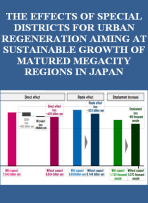The Effects of Special Districts for Urban Regeneration Aiming at Sustainable Growth of Matured Megacity Regions in Japan
It has become commonly accepted that promoting agglomeration in a global city-region will contribute to the nation-wide economic growth in the world since the beginning of 21st century with the escalation of intercity-interregional competition (World Bank 2009). In Japan, the national government has tried to switch from the traditional “nationwide well-balanced development,” policy to the new policies which aim at strengthening urban agglomeration, particularly in Tokyo, as the engine for national economic growth. One of the most significant examples representing the new policies has been the urban regeneration policies including the system of Special Districts for Urban Regeneration (SDUR).
This study aims at clarifying effects of SDUR established by Japanese national government in the year 2000 in order to promote structural shift of traditional urban planning policies, focusing on the examples in Tokyo and Osaka metropolitan areas. In particular, this study tried to evaluate the roles of the SDUR focusing on the aspects of new methodology based on promoting private initiative in planning proposals. Only our past papers (Kitazaki 2011, Kitazaki and Arita 2013) conducted the comprehensive surveys on the results of all the past examples of SDUR applied.
Tài liệu được định dạng file PDF(.pdf)
Xem chi tiết tài liệu trong phần Nội dung tóm tắt:
(bt)
